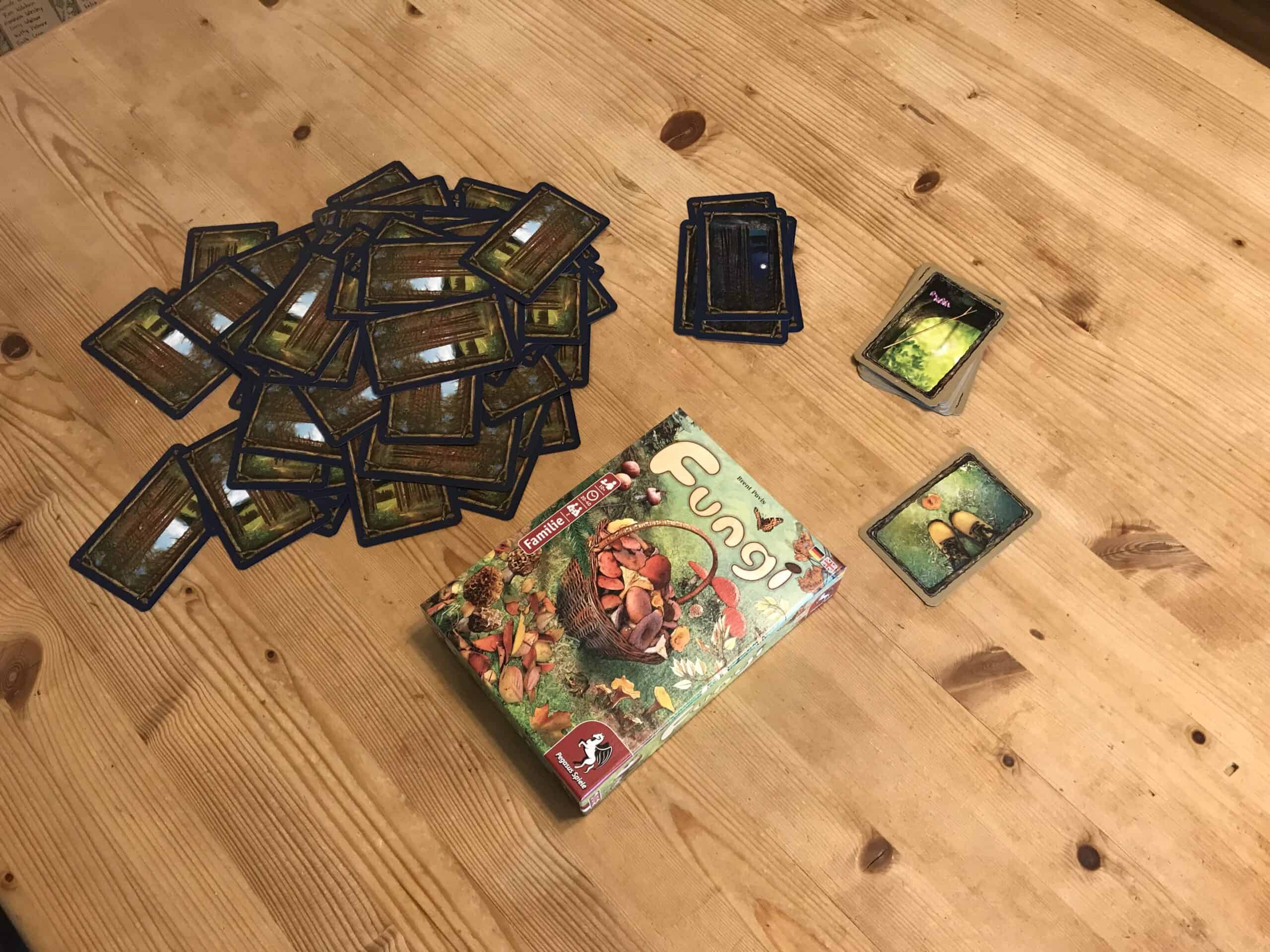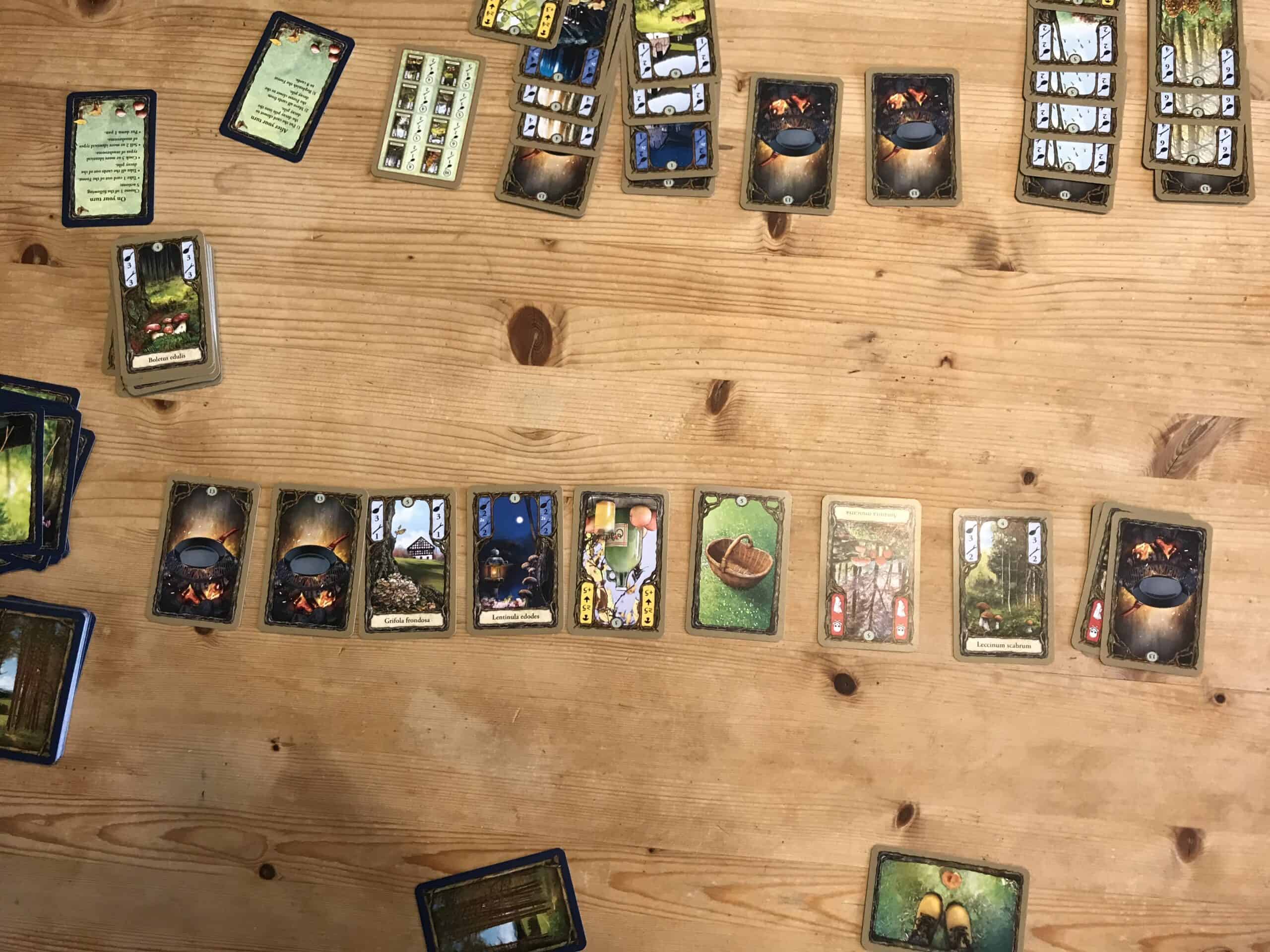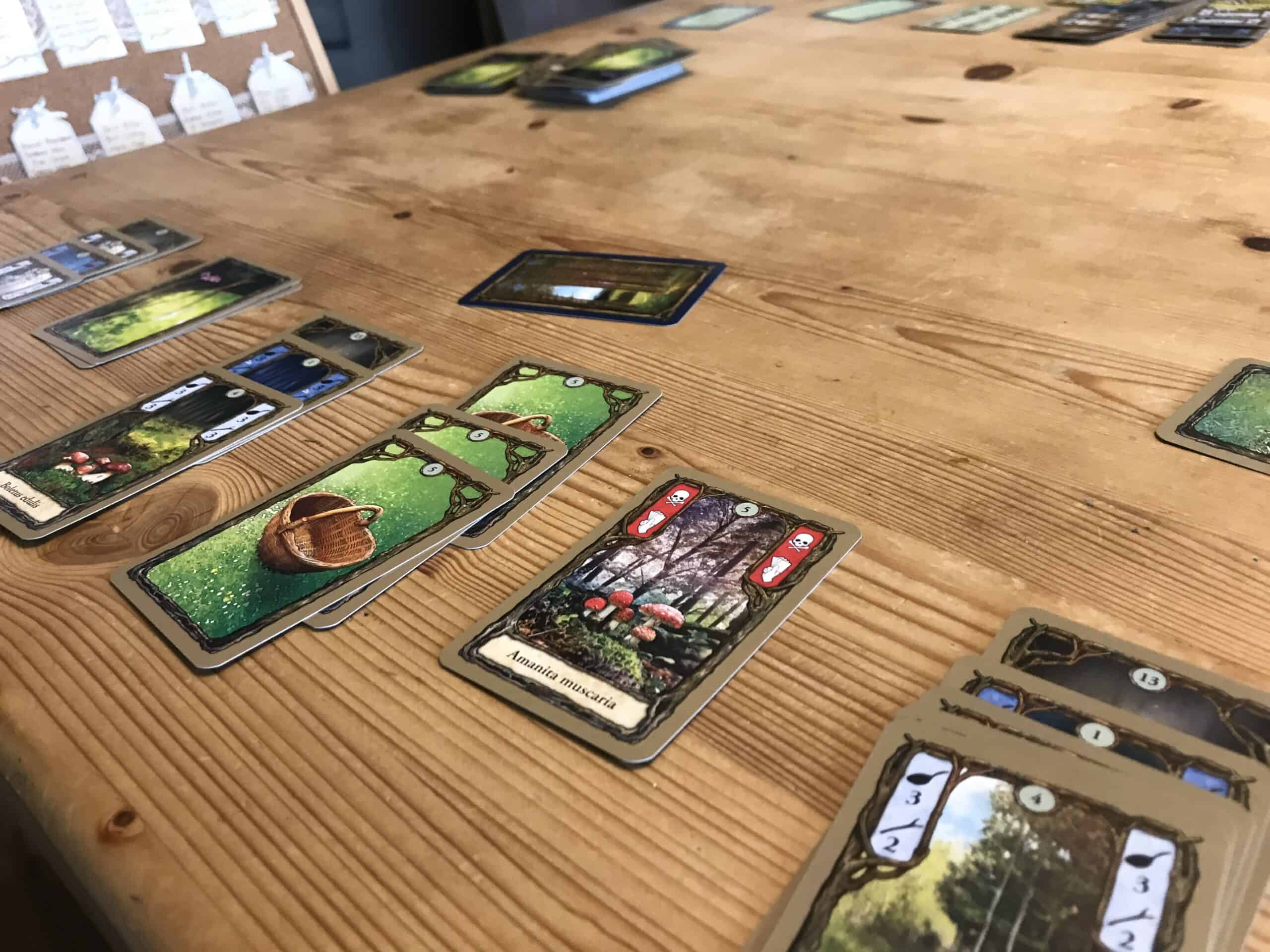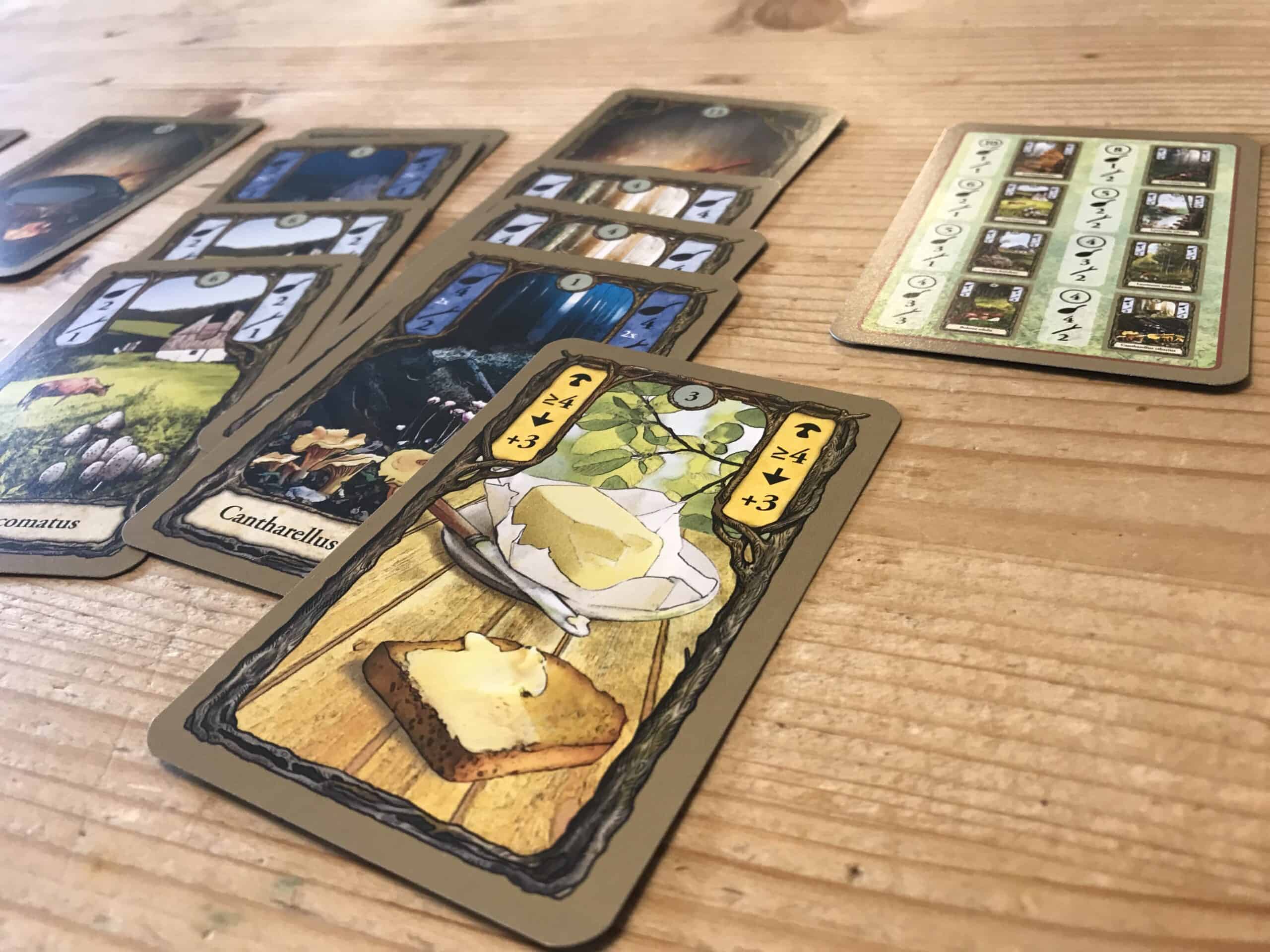Have you ever dreamed of trading mushrooms for sticks? No? Neither has anyone else. But if that concept mashed into a card game sounds appealing, Fungi is for you.
It’s a bit like a thematic, more complicated version of Rummy’s traditional card game. There are more steps, and the rounds take longer, but the concept of combining sets of cards is the overriding goal.
Bottom Line Up Front
The objective of this game is to match high-scoring mushroom cards with at least three of the same kind. You need to connect three (or more) mushrooms of the same type and put them in your “pan” to score.
In this Fungi card game guide, I’ll walk you through how to play, what you need to know, and some strategy tips.
Before you Begin

The instructions are reasonably long. Although the game is only 20 to 40 minutes (I’ve found the official estimate to be pretty accurate, in this case), you’ll need half an hour to learn the rules. It’ll also take you a couple of rounds to get used to the tactics. Overall, though, there’s nothing too complicated going on here.
Once you know what’s going on, games should be nearer the 20- or 25-minute mark.
In the end, Fungi is a simple game. There are just lots of steps to it. Although the instructions might look disheartening, never fear. Take it step by step, and you’ll pick the rules up in no time.
Before you start, ensure you have a big enough playing area. Even though this is only a two-player game and doesn’t take up as much room as some others, you’ll find many cards in play by the end. I’d recommend a large table or, failing that, playing on the floor.
I’ve chosen to explain the standard “straight-line” setup in this article. I’ll also walk you through the alternative format, which I highly recommend once you know how to play.
What’s In the Fungi box?
Before getting started, check you have all the relevant cards. In the box, you should have:
- 86 Forest cards (these have a daytime back)
- 18 Sticks
- 8 Night cards
- 6 Overview cards (instructions and reminders)
- 1 Pair of Shoes card
The Forest cards will function as the main draw pile. As you progress, you’ll have the option to take random Night cards – these are double-value options, but the mushroom type you pick is random. You’ll also have the opportunity to trade mushrooms in for Sticks.
Setting the Table Up for Fungi

Remove two Pan cards from the Forest deck and give one to both players. Place this Pan card in front of you on the left in what will become your Display.
Next, shuffle the Forest deck, ensuring you do this thoroughly. Place it on the table between you, off to one side. Draw eight cards from the top of the deck, placing them in a line, one by one, across the space. Put the Pair of Shoes card perpendicular to this line, next to the last two cards (those furthest away from the Forest deck). There should be space beyond the end of the Forest for the Decay pile.
Place the shuffled Night deck and the pile of Sticks (no need to shuffle these – they’re all the same) near the Forest deck. There should also be room for a Discard pile in this area before the Forest line starts.
Ensure each player has Overview cards as well as their Pan. You can put these off to the side.
Now, deal three Forest cards to each player, face down. These form your hand at the start of the game and should be kept hidden from the other player. Most cards stay in your hand. However, there are a couple of exceptions. If one of the three is a Basket, put it straight into your Display and don’t draw a replacement. If you have a Moon card, place it in the Discard pile and take one of the Night cards, adding it to your hand. Finally, if you have a Fly agaric, put it straight on the Discard pile, and don’t draw another Forest card.
You’re now ready to play.
Understanding the Forest, Sticks, and Decay and Discard piles
The Forest
The line of eight cards in front of you is known as the Forest, as explained. The last two cards (those by the Pair of Shoes) will be the game’s primary (but not the only) point of focus. These two are known as the Forest in front of your feet (yes, it’s a mouthful, but this is a German game!). The remaining six cards are referred to as the Deep Forest. Much better.
Sticks
The cards in the Forest in front of your feet can be selected for free each turn if you choose. The Deep Forest cards are out of reach unless you have the relevant number of Sticks. The first card in the Deep Forest costs 1 Stick, the second 2 Sticks, and so on, all the way up to the sixth.
Decay
The Decay pile, which should be located after the Forest in front of your feet, can contain up to four cards. I’ll explain how the Forest cards end up here in the How to play section. It’s essentially a temporary Discard pile. Don’t align these cards perfectly – seeing each one is essential.
As in the list of actions seen below, you could take the cards from the Decay pile (provided you meet certain requirements). Once the Decay pile reaches four cards and the next player doesn’t take them on their go, place all of them into the Discard pile. Start a new Decay pile from the last card moved from the Forest.
Discard Pile
You can’t use anything from the Discard pile. Once it’s gone, it’s gone. Some cards (like Moons) go straight to be discarded, bypassing the Decay pile.
Special Cards
Most cards in Fungi go into your hand when you pick them up. However, there are three exceptions.
- Baskets
- Moons
- Fly agarics (the poison mushroom!)
Baskets
Baskets add two to your hand limit. At the start of the game, your hand limit is eight. Whenever you pick up a Basket, you immediately place it in your Display area. If you have one Basket down, you can have ten cards in your hand. Two baskets mean 12, three mean 14, and so on. They’re well worth collecting.
Moons
When you take a Moon card, you must immediately place it in the Discard (not the Decay) pile. Then, take a Night card and add it to your hand. These mushrooms are worth double, but they’re random. You don’t know what you’re going to get. Of course, you can’t pick up a Moon and collect a Night card if you’ve already reached your hand limit.
Fly Agarics
Fly agarics are instantly placed in the Display and temporarily reduce your hand limit by four. They’re in effect for the current turn and the next one. For instance, if you have a Basket in your Display, playing a Fly agaric reduces your hand limit to six for this turn and the next. You must place cards from your hand in the Discard pile to bring your hand down to the new temporary limit.
After the next turn, you put the Fly agaric in the Discard pile. This final action doesn’t count as your turn. You should avoid collecting these cards unless you get stuck with random mushroom selections in your hand and have no way to go. Since there’s no option to discard from your hand, choosing and playing Fly agarics at the right time can help you out.
Butter and Cidre
Butter and Cidre are extra cards. You add them to your mushrooms for bonus points when you cook them in the Pan.
To add Butter, you must have combined at least four identical mushrooms. For adding Cidre, you must cook at least five.
If you end up with many identical mushrooms (for example, there are ten Honey fungus cards), you might be able to add multiple Butters or Cidres. The requirements apply to each card. So, if you have eight identical mushrooms, you could add two Butters. If you have nine, you could add a Butter and a Cidre, and so on.
How to Play Fungi

At the start of the game, your hand limit is eight cards. This number varies as you progress through the game and pick up Baskets or Fly agaric cards.
According to the official rule book, the player to go first is the last person to have had “mushrooms for dinner”. In my experience, nobody really cares about this. There aren’t many people in the world who can say, “Ah, yes, the last time I ate mushrooms for dinner was the 21st of July, 2019.” It’s a nice touch from the developers, but you’re probably better off tossing a coin or going with the traditional “youngest first” approach.
Each turn, you get one action. You must do one of these actions if possible. If you can’t do anything (usually because you’ve hit your hand limit by accident!), you’ll need to watch the other player taking as many turns as they want until you can go again. Torturous.
You have five options:
- Take a card from the Forest.
- Put a Pan down.
- Cook three or more identical mushrooms in a Pan.
- Buy Sticks by trading in two or more identical mushrooms.
- Take all the cards (up to four) out of the Decay pile.
More on these in a moment.
After your action, the last Forest card on the table moves into the Decay pile. You then move those remaining down the table, drawing enough cards from the deck to restore the Forest to eight. There will now be at least one new card on the table and in the Forest in front of your feet. The turn now passes to the other player.
You must always move the last card into the Decay pile and restore the relevant number of cards to the Forest at the end of each turn.
1. Take a card from the Forest
In most games, this will be the most common move. This is where you can choose cards to add to your mushroom collections in your hand. Remember, you’re aiming for three identical cards. Keep an eye on how many there are of each (it’s the big number in the top-center of each card).
The two cards from the Forest in front of your feet are “free”. You can take one of them, no questions asked. Don’t forget that the other will automatically move into the Discard pile by the nature of the rules.
If you want to take a card from the Deep Forest, you’ll need some Sticks. See below for more information on how to collect Sticks. When you use Sticks to take a card, place them back onto the Sticks pile, ready to be rebought if necessary.
Put cards straight into your hand unless they’re a Basket, Fly agaric, or Moon, in which case play them immediately.
2. Put a Pan down
The Pans are the vital thing you need before you can cook three or more identical mushrooms.
If you take a Pan from the Forest, you must put it in your hand. You can’t play it on the same go. After your opponent has their turn, place the Pan in your Display area.
The usual Decay procedure then resumes, and your turn ends.
3. Cook three or more identical mushrooms in a Pan
This is the ultimate objective of the game. Cooking your mushrooms in your Pans is the equivalent of banking your points. At the end of the game, only the cards in your Pans count towards your final Flavor score. Everything in your hand is worthless.
Flavor points are noted in the top corners of each card. They’re next to the pan symbol.
To cook mushrooms in a Pan, you must have an empty Pan in your Display. See the move mentioned above.
You must have at least three of the relevant mushroom to cook with it, although you could have as many as you want. See the FAQs at the bottom of this page for a complete list of mushroom cards. Don’t forget to add Butter or Cidre wherever applicable. It’s best to get these down wherever you can.
Cooking mushrooms is your turn. You don’t pick anything up, and the Decay process happens as usual.
You can’t add mushrooms (or Butter or Cidre) to a Pan you’ve already cooked in. Once you add the cards, that’s it. There’s no adding to or taking away from it.
4. Buy Sticks by trading in two or more identical mushrooms
You can trade the unwanted mushrooms in your hand for Sticks. You must have at least two of the same card type.
Place these into the Discard pile. You receive the relevant number of Sticks (noted in the top corners of the cards) for each mushroom. For example, if you sell three Armillaria mellea (Honey fungus), you receive three Sticks. Each is worth one Stick.
Once you have Sticks, you can use them to take cards from the Deep Forest. Place them in your Display. Any Sticks left over at the end of the game aren’t worth anything, so don’t over-invest in them.
5. Take all the cards (up to four) out of the Decay pile
You can take all the cards from the Decay (not the Discard!) pile if you like. However, your new total mustn’t exceed your hand limit.
Add everything to your hand when you take the Decay pile, but immediately play any Baskets, Fly agarics, and Moons.
If the Decay pile contains Baskets, these contribute to your new hand limit. For example, imagine your hand limit was still set at eight, and you had seven cards in your hand. Now pretend the Decay pile has a Basket in it. You are allowed to pick up the Decay pile because you’ll immediately place the Basket in your Display. This ups your hand limit to ten and means you’re only adding three cards to your hand, keeping it within the limit.
Bear in mind that Fly agarics also impact your total hand limit, even if only temporarily.
Ending the Game

The game finishes when the last card from the Forest has been taken. It stops immediately. Don’t finish the turn or allow each other one last go. It’s like that moment on a cookery show when the hosts force the contestants to “Stop cooking!”
Count up the total number of Flavor points simmering in your Pans. Night cards are worth double (as shown on them). Add on the values of any Butter or Cidre you’ve thrown in, too.
Whoever has the most Flavor points wins the game. If you tie, whoever has cooked the most mushrooms wins. Night cards count for two, again, but Butter and Cidre aren’t made of mushrooms, last I checked – so they don’t apply here.
If you still tie? You just tie. I don’t know, play again?
Alternative Forest Setup
After playing a few rounds of what I’ve called the “straight-line” setup, you’ll appreciate this so much. Trust me. The alternative Forest and Decay setup means you spend much less time sliding the cards around and, in my opinion, makes everything flow much better.
Set everything out the same way as before except the overturned Forest cards and Decay pile.
This time, put the Decay pile directly between you in the center of the table. Imagine there are spaces for ten cards around the empty pile, in either a rectangle or circle (a rectangle works best).
Draw eight cards from the Forest deck and add them to the ten imaginary spaces around the as-yet unused Decay pile. Of course, two of these “spaces” will remain empty. Now, place the Pair of Shoes card by the end of the Forest (the two cards after the open spaces, clockwise).
Play as described above, completing your actions and moving the end Forest card into the central Decay pile at the end of each turn. This time, though, move the Pair of Shoes card clockwise around the circle/rectangle instead of shuffling the cards along. There should always be two empty spots, remember.
This was definitely our preferred way to play, although I’d recommend getting used to the rules with the standard method first.
Tips to Know in Advance

Here are a few critical things to remember. I’ve learned them the hard way.
- It’s so important to shuffle the cards well, both the first time you play and between every other round. You can end up with lots of the same cards in one go. It’s incredibly irritating when, like in my first game, you end up with four Fly agarics in a row right at the start! That makes things much more difficult.
- Keep an eye on your hand. It’s easy to give things away that you’ll find – or remember with a smack to your own face – were supposed to be critical to your strategy. In the same vein, watch your hand limit! If you get too close to it, you’ll suddenly find yourself stuck with no way out.
- What’s won it for me several times is the Morel cards. There are only three in the pack, so you must hold them in your hand for a long time – but it could pay off. If, of course, the other person hasn’t collected them too. You could also go all in for the Night cards, hoping to get the double-points version and add it to your Pan. If you’re fortunate, you might even collect five (the Night version counts as two). Adding a Cidre to a full Pan of Morels adds insult to injury. It’s brilliant.
- Once you’ve played one or two rounds of the “straight-line” version, you don’t need the Pair of Shoes card. It’s easy to remember that you’re only allowed to take from the last two Forest cards (or use Sticks) without additional reminders. Removing this from the table makes things that little bit less cluttered.
- In the standard setup, you have to move the ingredients along one or two spaces at a time, at least once per turn. You might start getting fed up with this process. Unfortunately, there’s no real way around it. Because of this, playing on a slippy surface is much better. You might think I’m just being picky, but you’re going to be sliding cards around all the time. It will take even longer if you try playing on a high-pile carpet or rug. Play on a smooth surface like your clean kitchen table if you can.
- It’s definitely worth playing in the alternative circle format if you can learn it. It’s easier to learn to play using the standard straight-line form, but we’ve found the circle method much more manageable. It takes up more room, but you’ll get much less frustrated with moving the stacks of mushrooms towards the Decay and Discard piles.
Long-Term Goals to Consider
Remember, you’re aiming to collect high-value mushrooms and bank them by cooking them together in your pans. The more you put into your Pan at once, the greater their value.
Card Counting
It’s a game of risk and reward. As are all games – nothing new there. In the end, you need to weigh up the cards that are likely to show up next, along with how likely you are to be able to get them. As a result, the best way to win? It’s card counting. Learn the number of each card in the deck, and keep track of what’s come up and what’s likely to come up next. There’s no need to learn these numbers off by heart – they’re on the information card in front of you.
Get Baskets Quickly
Also, get the baskets as quickly as possible. Increasing your hand limit makes it much easier to collect many high-value mushrooms. By the end of the game, it’s too late to waste your efforts grabbing them. I’d suggest aiming for at least two or three Baskets as soon as possible.
Focus on High-Value Mushrooms
I’ve found that the best strategy is to focus on the higher-value mushrooms. Go big or go home. You only have to beat the other player – there are only two of you. Chances are if you can’t collect the high-points cards, the other player can. Therefore, there’s no other way to guarantee your victory.
I’ve given the “lots of low-value mushrooms plus Butters and Cidres” strategy a go a couple of times. The result? Nope, it really didn’t come off. I wouldn’t recommend it unless the stars so align that way.
Conclusion
In the end, the long-term aim of any two-player game should be quality time together. Fungi is an in-depth yet simple game and one I’m sure you and your friend can enjoy. It isn’t too expensive, either – you can pick a copy up for around $15. It’s pretty lighthearted and great for families. You can’t do much to get in each other’s ways, so it’s more about your memory and risk evaluation strategies.
Overall, it’s a harmless-enough game. While it might not be first on the list for intense gamers, it’s great for whipping off the shelf for a quick round or two.
Frequently Asked Questions
Question: How many of each mushroom card are in Fungi?
● Armillaria mellea (Honey fungus) – 1 Flavor point, 1 Stick value – x10
● Auricularia auricula (Tree ear) – 1 Flavor point, 2 Stick value – x8
● Coprinus Comatus (Lawyer’s Wig) – 2 Flavor points, 1 Stick value – x6
● Lentinula edodes (Shiitake) – 2 Flavor points, 2 Stick value – x5
● Grifola frondosa (Hen of the Woods) – 3 Flavor points, 1 Stick value – x5
● Leccinum scabrum (Birch bolete) – 3 Flavor points, 2 Stick value – x4
● Boletus edulis (Porcini) – 3 Flavor points, 3 Stick value – x4
● Cantharellus cibarius (Chanterelle) – 4 Flavor points, 2 Stick value – x4
● Morchella esculenta (Morel) – 6 Flavor points, 4 Stick value – x3
● Amanita muscaria (Fly agaric) – x5 (not worth any Flavor points or Sticks – used to reduce your hand size temporarily)
Question: What’s the best setup for the Fungi card game?
Answer: I’d recommend using the alternative setup. This involves using a circle or rectangle to surround the Decay pile. Instead of shifting the cards along each turn, just move the Pair of Shoes card.
The only exception? The standard setup is easier to understand if it’s your first time playing. Learn the ropes using this one and then move across the alternative. Thank me later.
Question: Why would you use Fly agaric cards in Fungi?
Answer: They might seem a little non-sensical, and much of the time, there’s no need to use them. However, Fly agarics can be significant.
In Fungi, you can’t discard a card whenever you want. You could sell two or more identical mushrooms, but these are often the ones you most want to keep! So, how do you get rid of your unwanted cards? Use a Fly agaric!
It’ll temporarily reduce your hand limit by four, forcing you to get rid of any four cards you don’t want. They also go straight into the Discard pile, so your opponent can’t use them. The more you think about it, the more crucial the Fly agaric cards are!
Looking for more interesting readings? Check out:
- Terraforming Mars Guide: Fighting for Spaces in Space - April 22, 2023
- Zathura Board Game Guide - April 20, 2023
- Ark Nova Guide – Zoo Complex, Or Complex Zoo? - April 8, 2023


